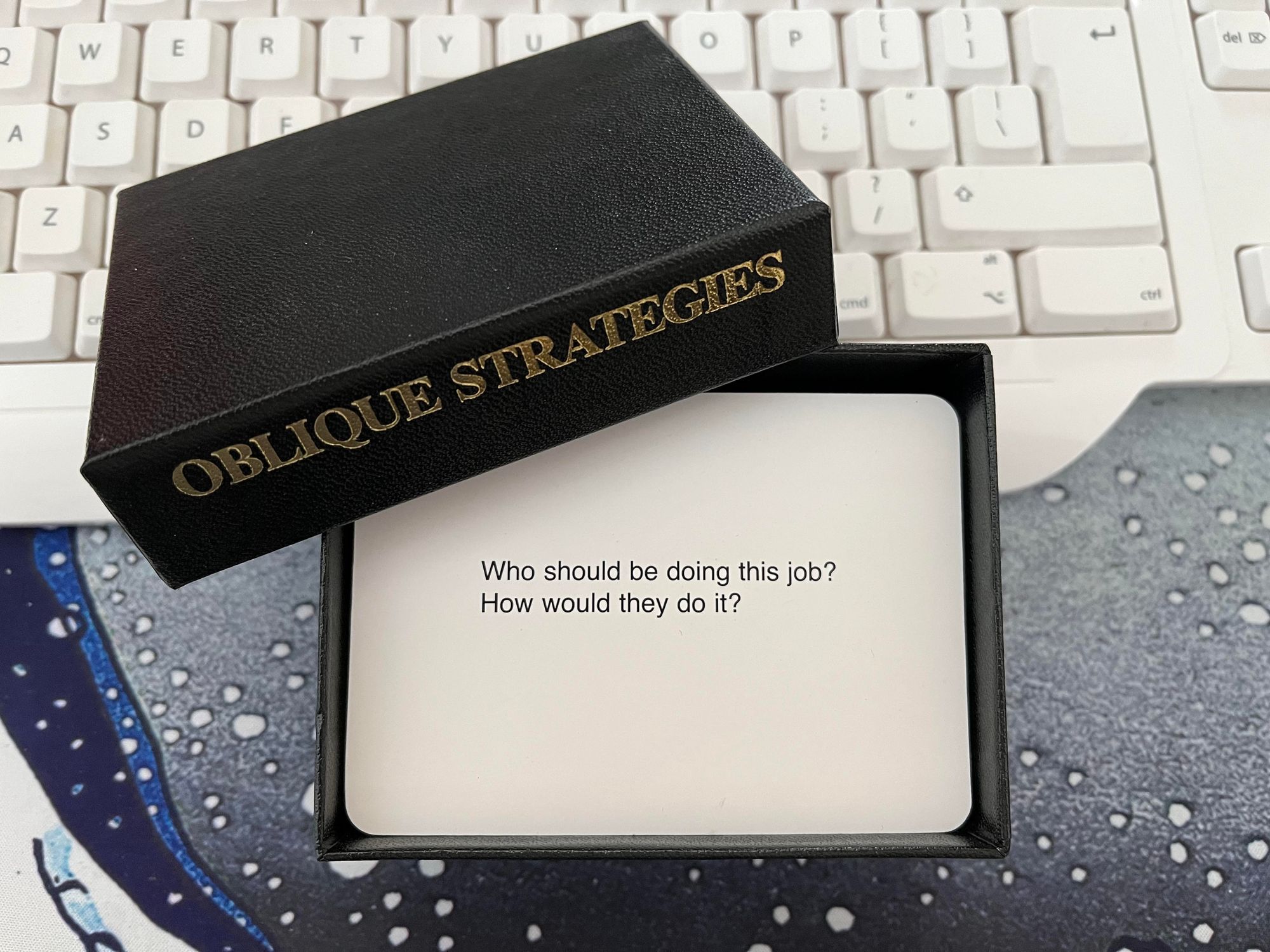Learning from Other Industries - Oblique Strategies
What can the arts teach us about inspiring creativity when it comes to technology? In the second of a series of blogs about what technology can learn from other industries, our Global Solutions Director looks into what we can learn from the arts when it comes to finding innovative solutions.

Don’t be afraid of things because they’re easy to do.
In 1975, musician, producer, and artist Brian Eno, and multimedia artist Peter Schmidt released a deck of cards called 'Oblique Strategies'. Each card contains a simple phrase or sentence designed to act as an inspirational phrase for artists, and especially musicians. Now, we’re not talking about inspirational phrases such as “If you can dream it, you can do it”, or “Hard work never killed anybody, but why take a chance?”. The Oblique Strategies were specifically designed to be just opaque and unspecific enough to get the creative juices flowing, and after nearly 50 years, they have continued to be admired and used by all types of artists all over the world.
It's a simple idea, and often ridiculed as such, but a powerful one. It’s like having a mentor on tap, who will throw you a leftfield idea to get you thinking in ways you’ve never done before, or in ways you’re resisting. Admittedly, a mentor that has no idea what you’re actually trying to do, but still…
Question the heroic approach.
Collaboration is key to innovation, technology, and software design and development, but collaboration has its own pitfalls. Groupthink is extremely easy to fall into when the group has a shared goal and a seemingly clear vision, and the momentum generated by this can lead to that terrible, disappointed, and underwhelmed state where everyone steps blinking out of the darkness of delivery and witnesses what they’ve actually put together. You know it, you’ve been there.
To counteract this, many teams will try to encourage freer thinking, exploration and questioning at every step of the process, but it’s not always easy to think outside of the box when you’ve been living and breathing in it for months.
Honour thy error as a hidden intention.
One of the biggest issues in the creative arts is keeping the creativity truly creative. It’s far too easy to fall into known, comfortable, and trusted patterns, and keep churning out the same old thing over and over again. This is what Eno and Schmidt were doing with Oblique Strategies - trying to get artists to at least try something different, and see how it goes. Only by doing something different, can we do something extraordinary. Even if what you try is complete nonsense, it can open up other avenues, or at least close a few fruitless options off for you. Make a mess, have a look at it, and see what it tells you.
Discover the recipes you are using and abandon them.
Wait, what? Why do we even need creativity and “free thinking” in technology? We just need to ship product on time, and to budget, and with a few bugs as possible, don’t we?
Well, yes, of course. You could go that way with every project if you want. If all you want to do is deliver technologies to spec, submit your invoice, and move on, go for it.
But, if you want to really help your clients and customers, if you’re driven to deliver the best possible functionality and experience to your users, then you’ve got to get at least a little jiggy with the creative mojo, daddy-o. Or however it is the kids are describing it these days.
Courage!
Fostering an environment where everyone’s input is valued, where every fresh idea can be at least acknowledged, if not actively explored, is one of the key drivers in innovation. Allowing people to question the “Whys” of a solution as well as the “Hows” gives team members the confidence to try things, the courage to be wrong and be questioned, and a real sense of ownership of what they are producing.
So… how many times have you heard that? A good handful, I’ll wager. Every third blog out there is banging on about how important creativity, innovation, and an open-minded group dialogue is. The issue is how do you actually do it?
Accept advice.
This is where things like Oblique Strategies come into play. I’d highly recommend grabbing a pack and giving them a whirl in your next product session. Here’s some ideas of how they could be implemented to get you started:
- Overcoming design roadblocks: When faced with a design challenge that seems insurmountable, pulling a card from the deck can help approach the problem from a fresh perspective. The random prompt may offer a new way of looking at the problem, which could help to break through the roadblock and generate new ideas.
- Encouraging innovation: Oblique Strategies can be a useful tool for encouraging innovation and experimentation. By pushing everyone to think outside the box and explore new possibilities, the prompts on the cards can help to generate creative and unexpected design solutions.
- Promoting collaboration: In a collaborative setting, using Oblique Strategies can help to break down communication barriers and encourage team members to contribute ideas that they might not have considered otherwise. By providing a neutral prompt that everyone can respond to, the cards can create a shared starting point for brainstorming and collaboration.
- Generating ideas: The prompts on the Oblique Strategies cards can be used as a source of inspiration for generating new ideas. Teams can use the prompts as a jumping-off point for brainstorming sessions, or they can incorporate the prompts into design exercises to encourage creative thinking and ideation.
- Technical blockers: Stepping back from the maelstrom of a technical roadblock and revisiting the “Whys” is an invaluable skill. Whilst stepping back, grab a card from the deck and see if it makes you think about the solution in a different way.
Try faking it!
Of course, you don’t need to use Oblique Strategies itself. Just having someone in the room who is bold enough to ask the obvious questions, the not-so-obvious questions, and to proffer the daft ideas, can be enough to get everyone engaged and innovating. Often, it’s the makeup of the team that will help drive this kind of thinking.
But when you’re truly stuck, out of ideas, going round in circles, or just tired of the same old patterns, reach for an Oblique Strategy. I did with this blog post. Each subheading is a card from the pack, chosen at random, and I forced myself to make sense of it in the context of what I’m writing, in the order that it appeared.
And this has been the most interesting blog you’ve read today, hasn’t it?
Grab your deck here, if you fancy. It’s not an affiliate link or anything. I’m not that important.

